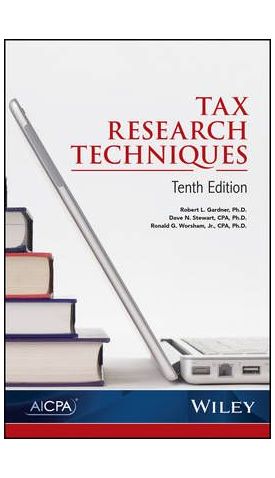אנו משתמשים ב-Cookies כדי לשפר את החוויה שלך. כדי לקיים ההנחיה החדשה של e-Privacy, עלינו לבקש את הסכמתך להגדיר את ה-Cookies. קבלת מידע נוסף.
386.00 ₪
Tax Research Techniques, 10e
386.00 ₪
ISBN13
9781941651476
יצא לאור ב
NC
מהדורה
10th Edition
זמן אספקה
21 ימי עסקים
עמודים
288
פורמט
Paperback / softback
תאריך יציאה לאור
26 במאי 2017
Tax Research Techniques provides a working knowledge of the methodology of implementation-based tax research. Drawing on the latest developments in online research, the authors reveal how to ask the right questions, organize the facts, locate and assess pertinent authority, and clearly communicate research findings.
Tax Research Techniques provides a working knowledge of the methodology of implementation-based tax research. Drawing on the latest developments in online research, the authors reveal how to ask the right questions, organize the facts, locate and assess pertinent authority, and clearly communicate research findings. The Trusted Research Training Manual for Over 30 Years As tax laws and tax research methods have changed over the past three decades,Tax Research Techniques has been a trusted resource to guide students and practitioners alike to best practices for efficient tax research. This latest edition updates examples and illustrations to highlight changes in tax law and online tax research over the past several years. Tax Research Techniques will sharpen your knowledge of these five key tax research procedures: * How to Get the Facts * How to Ask Expert Questions * How to Search for the Right Authority * How to Resolve the Question * How to Communicate Your Conclusions New and updated sections reflect the continuously evolving advances in the technology of Web-based research.
| מהדורה | 10th Edition |
|---|---|
| עמודים | 288 |
| פורמט | Paperback / softback |
| ISBN10 | 194165147X |
| יצא לאור ב | NC |
| תאריך יציאה לאור | 26 במאי 2017 |
| תוכן עניינים | Chapter 1: Tax Research in Perspective 1 Meaning of Research in General 2 Research for Implementation of Rules 2 Research for Policy Determination 6 Research for Advancement of Knowledge 7 Examples of Tax Research 7 Chapter 2: The Critical Role of Facts 11 The Importance of Facts to Tax Questions 11 Facts Established and Anticipated 13 Compliance 14 Planning 17 Some Common Fact Questions 19 Fair Market Value 20 Reasonable Salaries 21 Casualty and Theft Losses 21 Gifts 22 Illustrative Fact Cases 22 Gifts or Income? 22 Deductible or Not? 31 Chapter 3: The Elusive Nature of Tax Questions 55 Initial Statement of the Question 56 Minimal Technical Competence 57 Intermediate Technical Competence 58 Extensive Technical Competence 60 Restatement of the Initial Question After Some Research 61 Dangers Inherent in Statements of Questions 62 A Comprehensive Example 63 Diagramming the Facts 64 First Questions Call for Additional Facts 65 The Authority 67 Additional Questions 69 More Authority 69 More Questions and More Facts 70 First Tentative Conclusions 71 More Questions, More Authority 72 The Final Question 76 Summary 77 Chapter 4: Identifying Appropriate Authority 79 Statutory Law: The Tax-Legislation Process 80 The Internal Revenue Code 82 Treaties 88 Administrative Law 90 Treasury Regulations 90 Revenue Rulings 94 Revenue Procedures 95 Notices and Announcements 96 Letter Rulings 97 Technical Advice Memoranda, Determination Letters, and Chief Counsel Advice 98 General Counsel Memoranda 99 Action on Decision 99 Judicial Interpretations 100 US Tax Court 101 US District Courts 104 US Court of Federal Claims 104 US Circuit Courts of Appeals 107 US Supreme Court 108 Special Tax Reporter Series 109 Editorial Information 109 Tax Research Services 110 Treatises 113 Tax Journals 113 Tax Newsletters 114 Summary 114 Chapter 5: Locating Appropriate Authority 115 Online Services 116 Search Strategies 117 Finding a Known Primary Authority 117 Using a Table of Contents to Locate Authority 121 Using an Index to Locate Editorial Information 133 Using a Keyword Search 137 Formulating a Search Request 137 Issues 138 Terms or Phrases 138 Logical Connectors 141 Proximity of Terms and Phrases 141 Scope 142 Combining Search Strategies 145 Validating Tax Law Authority 146 Citator Databases 147 Searching Citator Databases 147 Validating Administrative Authority 152 Chapter 6: Assessing and Applying Authority 155 The Law is Clear The Facts Are Uncertain 156 The Facts Are Clear The Law Is Questionable 158 Conflicting Statutes 158 Conflict Between a Statute and the Intent of a Statute 159 Conflicting Interpretations 160 The Facts Are Clear The Law Is Incomplete 164 The Facts Are Clear The Law Is Nonexistent 169 Standards for Recommending a Tax Return Position 169 Chapter 7: Communicating Tax Research 173 Internal Communications 174 Memo to the File 174 Leaving Tracks 176 External Communications 177 Client Letters 177 Protest Letters 181 Requests for Letter Rulings and Determination Letters 186 Chapter 8: Tax Research in the Closed-Fact Case: An Example 195 Chapter 9: Research Methodology for Tax Planning 233 Tax-Planning Considerations 234 Statutory Options 235 Client Constraints 235 Creativity 236 Tax-Planning Aids 236 Editorial Materials 236 Continuing Education 237 Tree Diagrams 238 A Tax-Planning Example 239 Stock Versus Asset Acquisition 241 Other Considerations 241 Five Corporate Reorganization Options 242 Summary 245 Tax-Planning Communications 246 Appendix A: Tax and Business Websites for Researchers, Advisers, and Students 249 Appendix B: Circular 230 Considerations 257 Circular 230 Disclaimers 258 For Additional Information 259 Index 261 |
| זמן אספקה | 21 ימי עסקים |



Login and Registration Form